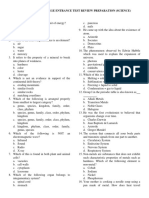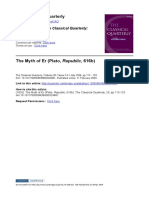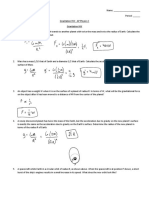0 ratings0% found this document useful (0 votes)
27 viewsPhy Sci - Module 1
Phy Sci - Module 1
Uploaded by
Rheyniel Escobel1. The document provides instructions for an assessment task involving multiple choice questions about astrophysics topics like what occurs in stars, the composition of the universe, and nuclear reactions.
2. It also includes open-ended questions to be answered about nuclear reactions involved in the formation of deuterium and light elements shortly after the Big Bang.
3. Additionally, it provides nuclear reaction equations to balance involving the formation of heavier elements through stellar nucleosynthesis after the formation of first-generation stars.
Copyright:
© All Rights Reserved
Available Formats
Download as DOCX, PDF, TXT or read online from Scribd
Phy Sci - Module 1
Phy Sci - Module 1
Uploaded by
Rheyniel Escobel0 ratings0% found this document useful (0 votes)
27 views3 pages1. The document provides instructions for an assessment task involving multiple choice questions about astrophysics topics like what occurs in stars, the composition of the universe, and nuclear reactions.
2. It also includes open-ended questions to be answered about nuclear reactions involved in the formation of deuterium and light elements shortly after the Big Bang.
3. Additionally, it provides nuclear reaction equations to balance involving the formation of heavier elements through stellar nucleosynthesis after the formation of first-generation stars.
Copyright
© © All Rights Reserved
Available Formats
DOCX, PDF, TXT or read online from Scribd
Share this document
Did you find this document useful?
Is this content inappropriate?
1. The document provides instructions for an assessment task involving multiple choice questions about astrophysics topics like what occurs in stars, the composition of the universe, and nuclear reactions.
2. It also includes open-ended questions to be answered about nuclear reactions involved in the formation of deuterium and light elements shortly after the Big Bang.
3. Additionally, it provides nuclear reaction equations to balance involving the formation of heavier elements through stellar nucleosynthesis after the formation of first-generation stars.
Copyright:
© All Rights Reserved
Available Formats
Download as DOCX, PDF, TXT or read online from Scribd
Download as docx, pdf, or txt
0 ratings0% found this document useful (0 votes)
27 views3 pagesPhy Sci - Module 1
Phy Sci - Module 1
Uploaded by
Rheyniel Escobel1. The document provides instructions for an assessment task involving multiple choice questions about astrophysics topics like what occurs in stars, the composition of the universe, and nuclear reactions.
2. It also includes open-ended questions to be answered about nuclear reactions involved in the formation of deuterium and light elements shortly after the Big Bang.
3. Additionally, it provides nuclear reaction equations to balance involving the formation of heavier elements through stellar nucleosynthesis after the formation of first-generation stars.
Copyright:
© All Rights Reserved
Available Formats
Download as DOCX, PDF, TXT or read online from Scribd
Download as docx, pdf, or txt
You are on page 1of 3
Assessment Tasks: MODULE 1
Task No. 1 (to be recorded as one of your Written Works)
Instructions: Read the questions carefully. Choose the letter of the correct answer.
1. What occurs inside a main sequence star?
a. Energy from fusion exceeds gravity.
b. Fusion shuts down.
c. Gravity exceeds energy from fusion.
d. It attains stellar equilibrium.
2. Which may be responsible for the accelerating expansion of the universe?
a. dark energy c. regular energy
b. dark matter d. regular matter
3. The universe comprises of ___________.
a. Hydrogen and oxygen c. Hydrogen and helium
b. Hydrogen and nitrogen d. Helium and nitrogen
4. First occurred after the Big Bang, the creation of new atomic nuclei, the centers of
atoms that are made up of protons and neutrons.
a. Photosynthesis c. Nucleosynthesis
b. Electrolysis d. Nuclear synthesis
5. Which is the most common type of star in the universe?
a. giant c. red dwarf
b. neutron d. white dwarf
6. Most of the matter in the universe has which form?
a. dark matter c. hydrogen gas
b. dark energy d. neutron
7. What is the distance light travels in one year?
a. 9.5 trillion km c. 7.5 trillion km
b. 8.5 trillion km d. 6.5 trillion km
8.What is the most accepted theory about the formation of the universe?
a. Big Bang theory c. Steady state theory
b. Nebular Theory d. Big crunch theory
9. Which is a true statement about the two nuclei?
a. They have the same atomic number.
b. They have the same mass number.
c. They have different numbers of electrons.
d. They have different numbers of protons.
10. What keeps particles in a nucleus together?
a. strong force c. electrical force
b. repulsion d. atomic glue
11. When ________ occurs, a nucleus splits into smaller nuclei. Neutrons and a large
amount of energy are emitted.
a. Nuclear bomb c. nuclear reaction
b. Nuclear fission d. nuclear fusion
12. What keeps particles in a nucleus together?
a. strong force c. electrical force
b. repulsion d. atomic glue
13. It is two nuclei with small masses combine to form a nucleus of larger mass.
a. nuclear bomb c. nuclear reaction
b. nuclear fission d. nuclear fusion
14. What is an electron that is produced when a neutron decay called?
a. an alpha particle
Task No. 2 (to be recorded as one of your Performance Tasks)
A. Instructions: Answer the following questions.
1. A proton and a neutron can be combined to form deuterium in the equation
n + p --> d + γ, to break up a deuteron, what is needed to produce its component
proton and neutron?
2. Describe the formation of light elements seconds after the big bang.
3. Explain the formation of heavier elements after the formation of first-generation
stars.
Task No. 2 (to be recorded as one of your Performance Tasks)
B. Instructions: Instruction: Balance the following equations (in the formation of
heavier elements)
1) 4He + 4He --> Be
2) 3He + n --> 4He
3) 20Ne + He --> 24Mg + γ
4) 12C + 12C --> Mg + γ
5) 57Fe + n ---> Fe + γ
You might also like
- The Kaznacheyev ExperimentsDocument33 pagesThe Kaznacheyev Experimentsblueberry58100% (3)
- Earth Space Science - Teachers' GuideDocument240 pagesEarth Space Science - Teachers' GuideMLSBU11100% (4)
- Physical Science: First Quarter - Module 1: Formation of Heavy ElementsDocument22 pagesPhysical Science: First Quarter - Module 1: Formation of Heavy ElementsDanTzyNo ratings yet
- 1st Quarter Test in Physical ScienceDocument3 pages1st Quarter Test in Physical ScienceDan Albert AbesNo ratings yet
- Physical Science (Exam) Answer KeyDocument10 pagesPhysical Science (Exam) Answer KeyNATHANIEL GALOPO100% (5)
- Summative Test 1 - Physical ScienceDocument4 pagesSummative Test 1 - Physical ScienceKennedy Fieldad Vagay75% (4)
- 1st Final Exam For 2nd Semester HUMSS With AnswerDocument5 pages1st Final Exam For 2nd Semester HUMSS With AnswerPrincess Ali Ma-ayaNo ratings yet
- Physical Science Activity in Quarter 1 Module 1: Name Score Year and SectionDocument5 pagesPhysical Science Activity in Quarter 1 Module 1: Name Score Year and SectionIily cabungcalNo ratings yet
- 1.4 Chem QDocument3 pages1.4 Chem QadarnafarahthereseNo ratings yet
- Physci Quiz Lesson 1 and 2Document1 pagePhysci Quiz Lesson 1 and 2JoHan Xyth RizaldoNo ratings yet
- Physical Science Summative Test FinalDocument2 pagesPhysical Science Summative Test FinalNATHANIEL GALOPO100% (1)
- 3RD Quarter Physical ScienceDocument3 pages3RD Quarter Physical ScienceAinon SalendabNo ratings yet
- First Periodical ExamDocument4 pagesFirst Periodical ExamWilson VillamaterNo ratings yet
- Physical Science 12Document40 pagesPhysical Science 12niña sampagaNo ratings yet
- Questionnaire For The StudentDocument6 pagesQuestionnaire For The StudentYHTAK1792No ratings yet
- Answer Key Summative 1Document2 pagesAnswer Key Summative 1kerbiy VivasNo ratings yet
- Lesson 01 - Physical ScienceDocument20 pagesLesson 01 - Physical ScienceAngelo Freidrich O AmbalongNo ratings yet
- 1-Formation of Light and Heavy ElementsDocument2 pages1-Formation of Light and Heavy ElementsCRISTINE RAYNESNo ratings yet
- Semester Exam Practice Questions: 1. C. D. C. D. C. D. C. D. C. D. A. C. B. D. C. D. C. D. C. D. 10. C. D. 11. C. D. 12Document9 pagesSemester Exam Practice Questions: 1. C. D. C. D. C. D. C. D. C. D. A. C. B. D. C. D. C. D. C. D. 10. C. D. 11. C. D. 12HaariniNo ratings yet
- Summative 1 Physical Science Answer KeyDocument2 pagesSummative 1 Physical Science Answer KeygjarandiaNo ratings yet
- Physical Science 11Document4 pagesPhysical Science 11nelson dante jr.No ratings yet
- Physical Science 11 - B and C Leah BagalihogDocument53 pagesPhysical Science 11 - B and C Leah BagalihogJohn Carlo Cabiles MellizaNo ratings yet
- Q3 Physical ScienceDocument3 pagesQ3 Physical ScienceJerwin Ayco100% (1)
- Stem Engine: College Entrance Test Review Preparation (Science)Document4 pagesStem Engine: College Entrance Test Review Preparation (Science)Anonymous rHn7ormVlNo ratings yet
- Physical Science Module 1 For Students.Document10 pagesPhysical Science Module 1 For Students.YUH JBWDHGNo ratings yet
- Physci Reviewer ExamDocument2 pagesPhysci Reviewer ExamJasper DelacruzNo ratings yet
- Third Periodic ExamDocument1 pageThird Periodic ExamJunnel MaravillaNo ratings yet
- Answer Sheet PHYSICAL SCIENCE m1 4Document8 pagesAnswer Sheet PHYSICAL SCIENCE m1 4Mark James RicoNo ratings yet
- 11Document3 pages11Senait KetemaNo ratings yet
- Pre Test Grade 11Document4 pagesPre Test Grade 11anon_409285199100% (1)
- 02 Atomic Structure Final PGCDocument18 pages02 Atomic Structure Final PGCcookiemaawNo ratings yet
- Pre-Test 1Document3 pagesPre-Test 1MICHELLE DE GUZMAN SOTTONo ratings yet
- Chapter 22 - Subatomic Physics Test 13-14 2Document10 pagesChapter 22 - Subatomic Physics Test 13-14 2Srood SalarNo ratings yet
- PHYSCI - Summative Assessment Test NoDocument8 pagesPHYSCI - Summative Assessment Test Nojenny feNo ratings yet
- Lesson Plan in Physical Science StellarDocument9 pagesLesson Plan in Physical Science Stellarartjill printingNo ratings yet
- PHYSICAL SCIENCE Long Test 19-20Document2 pagesPHYSICAL SCIENCE Long Test 19-20Kennedy Fieldad VagayNo ratings yet
- Physical ScienceDocument3 pagesPhysical ScienceJemimah Corporal100% (1)
- q2 Physical ScienceDocument4 pagesq2 Physical ScienceSeb GanaraNo ratings yet
- 2nd PeriodicalDocument7 pages2nd PeriodicalJunard AsentistaNo ratings yet
- Physical Science Module 1 Activities: Activity 1Document3 pagesPhysical Science Module 1 Activities: Activity 1Marcel Rinehart GudmalinNo ratings yet
- Summative Test IDocument2 pagesSummative Test IRanie EsponillaNo ratings yet
- Diagnostic Test in Science 9Document3 pagesDiagnostic Test in Science 9Pepito Rosario Baniqued, Jr100% (1)
- Third Quarter Exam in Physical ScienceDocument4 pagesThird Quarter Exam in Physical ScienceCarlo James SablanNo ratings yet
- 2nd-Unit TestDocument2 pages2nd-Unit TestCedric Tamares Evaristo100% (1)
- Nuclie MCQDocument6 pagesNuclie MCQGuru ki physicsNo ratings yet
- Physical ScienceDocument2 pagesPhysical ScienceCatherine VillaruzNo ratings yet
- Physical Science Midterm ExamDocument6 pagesPhysical Science Midterm ExamAngel Guillermo Jr.100% (1)
- National Entrance Screening Test Nest Entrance Exam 2021 For Niser 10 Full Length Mock Tests Solved Edugorilla Complete Practice KitDocument200 pagesNational Entrance Screening Test Nest Entrance Exam 2021 For Niser 10 Full Length Mock Tests Solved Edugorilla Complete Practice KitShashwat ShuklaNo ratings yet
- CONFUCIUS 1ST Periodical Test IN PHYSICAL EXAMDocument4 pagesCONFUCIUS 1ST Periodical Test IN PHYSICAL EXAMSuzette Ann MantillaNo ratings yet
- Physical Science Chemistry ModuleDocument67 pagesPhysical Science Chemistry ModuleTRISHA LOUISE OMERONo ratings yet
- Physical-Science11 Q1 MODULEDocument26 pagesPhysical-Science11 Q1 MODULELee GaoiranNo ratings yet
- Physical Science Chemistry Module 1Document65 pagesPhysical Science Chemistry Module 1Isnihaya AbubacarNo ratings yet
- 2nd Monthly Test in Science 9Document2 pages2nd Monthly Test in Science 9Rica De CastroNo ratings yet
- 3rd Quarter Physical ScienceDocument67 pages3rd Quarter Physical ScienceJennyvie CabayaNo ratings yet
- Chemistry Review Question For Grade 9 Unit 3Document5 pagesChemistry Review Question For Grade 9 Unit 3mtadesse158No ratings yet
- Physics G-11 U-7 WorksheetDocument5 pagesPhysics G-11 U-7 WorksheetbunniabebeNo ratings yet
- Dipolog City Science Ix: Zamboanga Del Norte National High School Science Department 1 Summative TestDocument3 pagesDipolog City Science Ix: Zamboanga Del Norte National High School Science Department 1 Summative TestJimar Decer CascoNo ratings yet
- Grade 12 - Science Set BDocument3 pagesGrade 12 - Science Set BjonaifahmangiginNo ratings yet
- What I Need To Know: Determine If A Molecule Is Polar or Non Polar Given Its Structure. (S11/12Ps-Liic-15)Document3 pagesWhat I Need To Know: Determine If A Molecule Is Polar or Non Polar Given Its Structure. (S11/12Ps-Liic-15)Theresa AgdeppaNo ratings yet
- Born - Natural Philosophy of Cause and Chance (1948)Document236 pagesBorn - Natural Philosophy of Cause and Chance (1948)Joel Rasch100% (1)
- Brihat Parashara Hora Shastra: Inauspicious Births (Chapter 85)Document5 pagesBrihat Parashara Hora Shastra: Inauspicious Births (Chapter 85)michael8douglas8neelNo ratings yet
- Project Pegasus Laura Eisenhower Statement Regarding The Positive Timeline 7-15-10Document5 pagesProject Pegasus Laura Eisenhower Statement Regarding The Positive Timeline 7-15-10Lawrence JonesNo ratings yet
- Zeitgeist, The Movie - Companion Guide PDFDocument220 pagesZeitgeist, The Movie - Companion Guide PDFKate Gilbertson100% (2)
- The Myth of ErDocument22 pagesThe Myth of ErClaudioRussoNo ratings yet
- Unit 11 NatureDocument41 pagesUnit 11 Naturejaneth sussyNo ratings yet
- No Clouds Stay in The Sky ForeverDocument1 pageNo Clouds Stay in The Sky ForeverYemima HanniNo ratings yet
- Unit Test 7 Answer Key: Audio 3 - 25Document1 pageUnit Test 7 Answer Key: Audio 3 - 25Be HajNo ratings yet
- Physical WorldDocument15 pagesPhysical WorldKashyap PatelNo ratings yet
- The Supreme BeingsDocument10 pagesThe Supreme BeingsJhe VictorioNo ratings yet
- Parashar Vol 1Document45 pagesParashar Vol 1dreamdreamgarlNo ratings yet
- ASMO L3 (G5&6) Science - UnlockedDocument14 pagesASMO L3 (G5&6) Science - UnlockedNicoleNo ratings yet
- Advancements On The Solar SystemDocument7 pagesAdvancements On The Solar SystemJohn Kenneth Adorablè EnocNo ratings yet
- Gravitation HW KeyDocument4 pagesGravitation HW KeyKatherine ZwienerNo ratings yet
- Test For SSCDocument12 pagesTest For SSCmonit gehlotNo ratings yet
- Revolutions in ConsciousDocument9 pagesRevolutions in Consciousrgovindan123No ratings yet
- Celestial BodiesDocument14 pagesCelestial Bodieslokapavani_senthilNo ratings yet
- Earth and Beyond (Grade 5 English)Document48 pagesEarth and Beyond (Grade 5 English)Primary Science Programme89% (18)
- New Microsoft Word DocumentDocument2 pagesNew Microsoft Word DocumentVd Vivek SharmaNo ratings yet
- Neptune: The Windy Eighth Planet From The SunDocument10 pagesNeptune: The Windy Eighth Planet From The SunДаша ГринюкNo ratings yet
- Tinnitus Clinical Case by SlidesgoDocument50 pagesTinnitus Clinical Case by SlidesgoFuad hadyanNo ratings yet
- Chronology of TroyDocument8 pagesChronology of TroyeengelbriteNo ratings yet
- Mark Maslin - The Cradle of Humanity - How The Changing Landscape of Africa Made Us So Smart-Oxford University Press (2017)Document256 pagesMark Maslin - The Cradle of Humanity - How The Changing Landscape of Africa Made Us So Smart-Oxford University Press (2017)valeriu.ispir11No ratings yet
- Cosmic PuzzleDocument1 pageCosmic PuzzleHartford CourantNo ratings yet
- Electromagnetic Waves in Plasma PhysicsDocument18 pagesElectromagnetic Waves in Plasma PhysicsSaidAbdullah360No ratings yet
- Inside: Mythological Characters Emerge From The BookDocument8 pagesInside: Mythological Characters Emerge From The BookrevatheeNo ratings yet
- Nda 1 Question Paper General Ability TestDocument25 pagesNda 1 Question Paper General Ability Test2006anshisinghNo ratings yet
- July 2023 Magical ElectionsDocument19 pagesJuly 2023 Magical Electionsishawitchcraft100% (1)

























































































